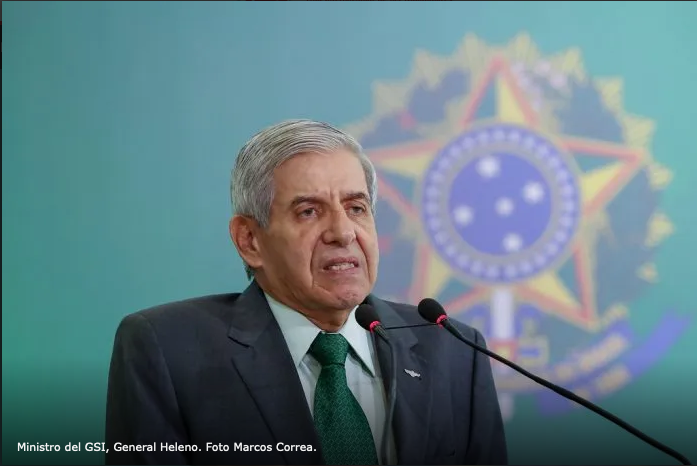Brazil | With Bolsonaro’s Support, the Amazon Suffers Another Gold Rush

December 14, 2021
On December 6, the newspaper “Folha de S. Paulo” published a report showing that this year, general Augusto Heleno, minister of the Institutional Defense Cabinet (GSI) of the Presidency, authorized seven gold-prospecting projects in the region of São Gabriel da Cachoeira (Amazonas). The final decision was made following various projects led by the National Mining Agency (ANM).
By: Jeferson Choma
The region, located in the northeast of the Amazonas state, is called Cabeça do Cachorro. It is one of the most preserved regions of tropical wilderness, and full of indigenous territories: approximately 23 different ethnic groups live in the region. The presence of indigenous peoples in São Gabriel is so strong that it is known as the capital of various indigenous languages, including Nheengatu, Tucano, and Baniwa languages.
Deforestation
All of the regions identified by the general are federal territories, neighboring indigenous territories. It is yet another action taken by the Bolsonaro government to incentivize the expansion of mining in the public lands of the Amazon, whether they are unoccupied (without specific purpose and not part of any particular ancestral territory), indigenous, or protected wildlife reserves.
What’s more, this criminal policy has resulted in the deforestation of 40,536 km2 of the Amazon over the past five years, according to data from the Real-Time Deforestation Detection System (Deter) run by the Special Research Institute of Brazil (INPE).
Insofar as it respected legally protected regions, deforestation due to mining increased by 80.62% in the first quarter of 2020 relative to its growth over the same period of the prior year according to the NGO Greenpeace.
Genocide of the people of the forest
Besides the wilderness itself, the people who live in it are the main victims of mining’s expansion, as it contaminates the environment, harms people’s health, creates violence, and disrupts traditional communities.
Indigenous peoples in particular are living under the threat of a new genocide. Currently, more than 3,000 requests to mine locations on indigenous territories of the Amazon are being processed by the ANM. According to the project “Mined Amazon” by InfoAmazonia, at least 58 requests have been approved. despite the fact that these incursions on indigenous land are prohibited by the Constitution.
Anglo-American mining companies control nearly half of the projects authorized by the ANM, with 27 granted requests to mine for copper in the indigenous territories of Mato Grosso and Pará. Their main target, the subject of 13 requests, is the land of Sawré Muybu (Pimental) in the southeast of Pará, the traditional territory of the Munduruku people.
Invasion and contamination
More than seventy years ago, the Munduruku people fought against the incursions of garimpo, clandestine mining operations, located in the middle of the Tapajos river. An investigation carried out by Fiocruz in collaboration with the WWF-Brazil shows that as a result of the “garimpeira” 100% of the indigenous population have suffered mercury poisoning.
The Yanomami people face the same situation in Roraima. Since the election of Bolsonaro, more than 20,000 garimpeiros have invaded their lands, murdered people, and polluted the rivers and the fish.
Nevertheless, Bolsonaro’s commitment to abetting the genocide of these peoples is so strong that the National Indian Foundation (Funai) prohibited Fiocruz researchers from studying the degree of mercury contamination in the Yanomami caused by mining.
Who’s who in the mining of the Amazon? Exploitation or “legal” mining: destruction, looting, and death
The garimpo of today bears little in common with the garimpo of other eras, such as during the 1970s in Serra Pelada. At that point in time, the Serra Pelada attracted poor peasants, working on highway construction projects funded by the dictatorship.
Later came the underdogs of what would become known as the “economic miracle”, and adventurers of all stripes. At one point, even the dictatorship promoted garimpo in an attempt to promote land settlement and impede the movements of guerrilla forces.
But today, garimpo is no longer financed by the garimpeiros themselves. And the garimperios do not come with pickaxes nor do they form a “human anthill”. The garimpo today is a big business, upending, polluting, and degrading much more land with the use of heavy machinery.
A criminal plan
Garimpo mining today is financed by politicians, businessmen, and organized criminals. They are the ones bringing vulnerable workers to these lands, who bribe community leaders. It is the heads of these cartels that are becoming rich, not the poor garimpeiro who works in conditions that sometimes resemble slavery (since 2008, 333 workers in garimpos have been rescued from such conditions).
Generally, garimpeira is associated with other illegal activities, such as illegal logging, cattle ranching, the invasion of public lands, drug trafficking, etc. In this sense, the illegal garimpo is just one part of the capitalist engine at work in the Amazon, which is now a “militia territory” controlled by criminal groups.
The destructive “legality” of capitalism
But, “legal” capitalist mining also exists and is undertaken by major companies, typically foreign ones. Supposedly, these companies are “less predatory”, and are thus authorized by the ANM. The failure of the filtration system of Hydro Alunorte in December 2018, which led to the contamination of various cities in Pará by mercury, arsenic, and lead, shows that this is a farce. There is no oversight, and the “legal” mining invades indigenous territories all the same.
Currently, mining companies are pushing for the loosening of environmental regulations, for example, the Project of Law 3729 that is being taken up by the National Congress, which proposes the end of environmental licensing.
Whether legal or illegal, mining in the Amazon means the destruction and genocide of indigenous peoples, while a half dozen criminals—whether they wear militia fatigues or business suits—make away with billions after the theft, pillage, and death.
First published in Portuguese on www.pstu.org.br, 8/12/2021.-
Translation to Spanish: Natalia Estrada
Translation to English: Carlos Sapir




